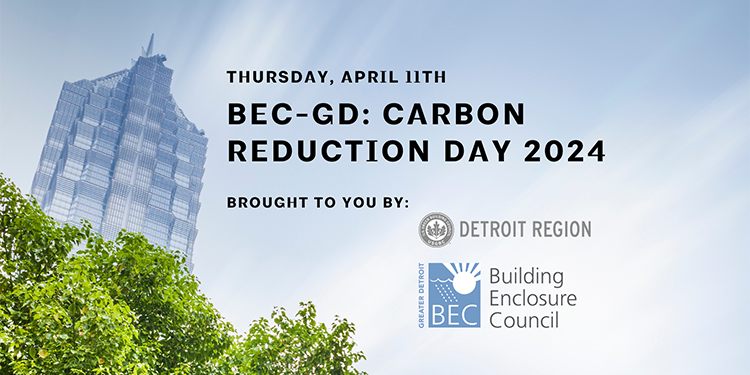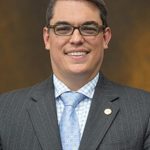
Date: April 11, 2024 | Time: 8:00 AM - 4:00 PM - 5
BEC-GD: Carbon Reduction Day 2024
The BEC-GD is excited to share this Spring 2024 program with you.
– $50 Registration includes breakfast, lunch, presentations, & sponsor displays.
(in-person attendance only)
– Located at the Holiday Inn Detroit Northwest – Livonia, an IHG Hotel | 17123 North Laurel Park Drive, Livonia, MI, 48152
Up to 5 hours of HSW (Health, Safety, Welfare) AIA Continuing Education Learning Units will be provided by AIA Detroit one approved. The USCBG is also acquiring GBCI credits.
EVENT AGENDA
8:00 AM: Check in/Continental Breakfast, Sponsor Displays/Networking
8:45 AM: Opening Comments
9:00 AM-10:15 AM: Presentation 1: “An Introduction to Embodied Carbon for Building Enclosures” with Patrick Keeney (1.25 LU/HSW)
10:15 AM: Morning Break, Sponsor Displays
10:45 AM-12:00 PM: Presentation 2: “Architecture Meets Operational Energy and Carbon” with Aaron Frantz (1.25 LU/HSW)
12:00 PM: Lunch Break, Sponsor Displays
1:00 PM-2:15 PM: Presentation 3: “A Sustainable Path Forward – Embodied Carbon & EPDs” with Todd Kimmel (1.25 LU/HSW)
2:15 PM: Afternoon Break, Sponsor Displays
2:45 PM-4:00 PM: Presentation 4: “Unlocking Sustainable Performance with Mass Timber” with George Berghorn (1.25 LU/HSW)
4:00 PM: Closing Remarks
PRESENTATION & SPEAKER INFO
An Introduction to Embodied Carbon for Building Enclosures
Patrick Keeney, AIA, CPHC, LEED AP O+M | Senior Associate of the Enclosure Diagnostics Team, Walter P Moore
Presentation Description:
In an effort to increase awareness and reduce the embodied carbon impacts of the building enclosure, this presentation will share research into current enclosure materials and building enclosure lifecycle assessment (LCA). The presentation will start by introducing embodied carbon, environmental product declarations (EPDs), and the product category rules (PCRs) that govern them and will conclude by giving a glimpse into where we are headed as an industry regarding future code and legislation requirements for low-carbon materials.
Learning Objectives:
1. Provide an overview of Scope 1,2,& 3 emissions, Environmental Impact Categories, lifecycle stages, and Environmental Product Declarations (EPDs) including the Product Category Rules (PCRs) that govern them.
2. Explain the scope of components typically included with building enclosure lifecycle analysis, along with various material benchmarking.
3. Highlight ongoing and upcoming carbon-focused code and legislation initiatives that are affecting building enclosure materials
4. Identify steps to integrate low-carbon strategies into projects for enclosure materials and systems.
 Patrick Keeney, AIA, CPHC, LEED AP O+M, is a Senior Associate and Senior Project Manager in Walter P Moore’s Washington DC Enclosure Diagnostics group. With more than a decade of experience in high-performance buildings, sustainability, and architectural design, Patrick specializes in building enclosures. Having extensive experience with building simulations, environmental analyses, and building science, he brings a performance-based decision-making process to each project.
Patrick Keeney, AIA, CPHC, LEED AP O+M, is a Senior Associate and Senior Project Manager in Walter P Moore’s Washington DC Enclosure Diagnostics group. With more than a decade of experience in high-performance buildings, sustainability, and architectural design, Patrick specializes in building enclosures. Having extensive experience with building simulations, environmental analyses, and building science, he brings a performance-based decision-making process to each project.
Patrick is a licensed Architect in Washington DC, Texas, & Louisiana, and a Certified Passive House Consultant (CPHC). He is a leader and active participant in numerous professional organizations, currently serving on AIA National’s Codes & Standards committee and the Chair of AIA|DC’s Committee on the Environment (COTE). Patrick holds a Master of Architecture and Master of Science in Sustainable Design degrees from the Catholic University of America in Washington, DC, and a Bachelor of Arts degree in Economics and Studio Art from Bucknell University.
Net Zero and Carbon Neutrality for the Built Environment
Aaron Frantz, PE | Associate at Peter Basso Associates, Inc.
Presentation Description:
Lowering a building’s operational carbon footprint involves far more than just meeting the energy code. In this presentation, we’ll explore how MEP systems emit operational carbon and how modern envelope designs will need to explicitly consider the effects they will have on energy usage. The presentation establishes the common language and metrics of operational carbon, explores how to reduce carbon without increasing utility costs, and debates whether current green power purchase programs are actually sustainable. Methods for applying data-driven design to building envelopes and practical suggestions for improving thermal enclosure performance are presented with case studies.
Learning Objectives:
1. Understand common methods of quantifying operational energy and carbon.
2. Discover how the fuel mix of utility grids affects carbon performance of the buildings they serve.
3. Learn about appropriate applications of prescriptive codes vs. energy modeling for low-carbon-emissions buildings.
4. Explore opportunities to implement thermally smarter envelopes, including high-performance applications of glazed assemblies.
5. Consider the effects of real-world operation on building energy performance, and how to design around user error.
 Aaron Frantz is an Associate at Peter Basso Associates, where he works as a Mechanical Engineer in their Corporate and Government market sector. His professional focuses include complex integrative design processes and using technology such as BIM and LIDAR scanning to improve project delivery. He frequently brings his expertise in energy modeling to early-phase energy planning and LEED projects, and is an internal subject matter expert on energy codes. He has worked on large sustainability-conscious high rise projects such as the One Campus Martius addition and Huntington Bank Tower in Detroit, as well as the upcoming Net Zero Energy Ann Arbor Fire Station #4. He holds a Masters degree in Mechanical Engineering from the University of Michigan, and serves on the Detroit ASHRAE Board of Governors.
Aaron Frantz is an Associate at Peter Basso Associates, where he works as a Mechanical Engineer in their Corporate and Government market sector. His professional focuses include complex integrative design processes and using technology such as BIM and LIDAR scanning to improve project delivery. He frequently brings his expertise in energy modeling to early-phase energy planning and LEED projects, and is an internal subject matter expert on energy codes. He has worked on large sustainability-conscious high rise projects such as the One Campus Martius addition and Huntington Bank Tower in Detroit, as well as the upcoming Net Zero Energy Ann Arbor Fire Station #4. He holds a Masters degree in Mechanical Engineering from the University of Michigan, and serves on the Detroit ASHRAE Board of Governors.
A Sustainable Path Forward – Embodied Carbon, EPDs and other Important Considerations
Todd Kimmel, CPHC, CDT | Chairperson at RAiNA & US Senior Manager Sustainable Solutions at ROCKWOOL North America
Presentation Description:
Along with energy conservation measures, sustainability trends are continuously becoming more robust with high focus on carbon emissions, product transparency and resiliency. Importantly, the embodied carbon impacts of building materials are becoming one of the primary measurements of a product’s sustainability. The use of Environmental Product Declarations (EPDs) is increasing where understanding the inputs and outputs of the lifecycle assessment are critical. This course will provide insight into these topics using stone wool insulation as an example, and relate them to overall durability, energy efficiency, and occupant health and comfort. These topics will be explored within the infrastructure of green building certification metrics and schemes such as LEED and local sustainability initiatives will be integrated. Best practices and user-friendly tools and resources to assist with sourcing sustainable products will be highlighted. Lastly, additional important considerations around product sustainability including durability, long term performance, fire-safety, circularity and design for deconstruction will be discussed.
Learning Objectives:
1. Understand the impact and benefits of stone wool insulation in relation to energy efficiency and carbon emissions.
2. Understand how to read and interpret Environmental Product Declarations (EPDs) of building insulation products.
3. Identify design strategies to improve the environmental footprint of buildings, along with improving the health and well-being of building occupants related to acoustical and thermal comfort, indoor air quality and fire protection.
4. Translate these findings and source appropriate environmental documentation to specify stone wool insulation for green building schemes such as LEED.
5. Understand the broader picture of product sustainability and be able to identify other considerations such as durability, long-term performance, fire safety, circularity and design for deconstruction among others.
 Todd Kimmel is the US Senior Manager of Sustainable Solutions for ROCKWOOL North America and Chairperson of the Rainscreen Association in North America (RAiNA). He has over 20 years of experience working on façade systems and the building enclosure, holding technical and business development leadership positions for multiple leading product manufacturers. He is a certified passive house designer and currently sits on the executive committee board of directors for New York Passive House (NYPH).
Todd Kimmel is the US Senior Manager of Sustainable Solutions for ROCKWOOL North America and Chairperson of the Rainscreen Association in North America (RAiNA). He has over 20 years of experience working on façade systems and the building enclosure, holding technical and business development leadership positions for multiple leading product manufacturers. He is a certified passive house designer and currently sits on the executive committee board of directors for New York Passive House (NYPH).
Unlocking Sustainable Performance with Mass Timber
George H. Berghorn, PhD, LEED AP, CGP | Assistant Professor and Research Director of MassTimber@MSU at Michigan State University
Presentation Description:
Mass timber is emerging as an alternate structural material to concrete and steel in a variety of building projects across Michigan, the Midwest, and the US. This presentation will focus on the role that mass timber can play in helping owners achieve sustainable performance goals for their projects. Starting with a brief overview of mass timber materials and building types, the presentation will focus on the life cycle sustainability benefits of using mass timber, from forest to final installation. Carbon accounting, supply chain length, and end of life/next life considerations will be discussed. Current opportunities to include mass timber in green building rating systems will also be discussed.
Learning Objectives:
1. Discuss the role of forest management and harvest in mass timber sustainability.
2. Describe the carbon performance of mass timber buildings.
3. Discuss opportunities to include mass timber in green building rating systems.
4. Identify end of life and next life strategies for mass timber materials and buildings.
 George H. Berghorn is an Assistant Professor of Construction Management in the School of Planning, Design & Construction, Research Director of MassTimber@MSU, and an Adjunct Assistant Professor of Sustainable Wood Construction in the Department of Forestry at Michigan State University (MSU). He earned a PhD in construction management from MSU and a Master of Environmental Studies degree from the Yale University School of Forestry & Environmental Studies (now the School of the Environment). His research is focused on mass timber construction management (competency-based education, construction project management process, modular modalities for affordable housing, barriers to adoption, predictive cost and time modeling, and end of life options), building deconstruction and circularity of wood building materials, and reuse of salvaged lumber in mass timber products. Prior to his career in higher education, Berghorn was an owner’s representative for a national engineering firm, a site superintendent and project manager for a medium-sized general contractor in the northeastern US, and a policy director for a statewide forest products trade association. He is a member of the Michigan-Finland Bioeconomy Working Group’s Wood Construction task team and a member of the Michigan Mass Timber statewide planning group.
George H. Berghorn is an Assistant Professor of Construction Management in the School of Planning, Design & Construction, Research Director of MassTimber@MSU, and an Adjunct Assistant Professor of Sustainable Wood Construction in the Department of Forestry at Michigan State University (MSU). He earned a PhD in construction management from MSU and a Master of Environmental Studies degree from the Yale University School of Forestry & Environmental Studies (now the School of the Environment). His research is focused on mass timber construction management (competency-based education, construction project management process, modular modalities for affordable housing, barriers to adoption, predictive cost and time modeling, and end of life options), building deconstruction and circularity of wood building materials, and reuse of salvaged lumber in mass timber products. Prior to his career in higher education, Berghorn was an owner’s representative for a national engineering firm, a site superintendent and project manager for a medium-sized general contractor in the northeastern US, and a policy director for a statewide forest products trade association. He is a member of the Michigan-Finland Bioeconomy Working Group’s Wood Construction task team and a member of the Michigan Mass Timber statewide planning group.
